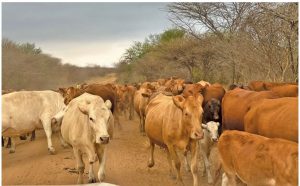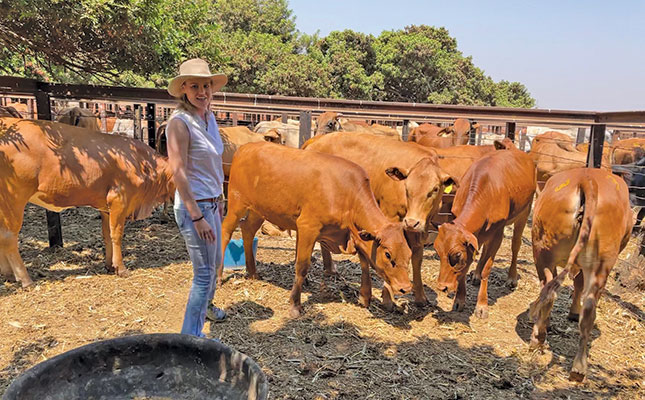Dynamic, robust and unfaltering, is how Kerry Stewart describes the Tuli breed. It was developed in Zimbabwe to thrive under often challenging climatic conditions. Stewart runs the LZ Stud near Gwanda in southern Zimbabwe.
The medium-framed Tuli comes in four basic coat colours: red, gold, ivory and dun. These colours and their sleek, shiny coats have enabled them to adapt well to the intense sunlight typical of Zimbabwe.
As the Tuli breed developed in relative isolation, it has a unique genetic make-up, being neither Bos taurus nor B. indicus, rendering it especially successful in cross-breeding programmes. A high degree of hybrid vigour is achieved, plus the added advantage of polled calves.
Taxing African conditions
Just like the Tuli breed, Stewart was also born and bred in Zimbabwe, and she grew up with the breed. She took over her family’s Tuli stud in 2014. The LZ Tuli stud was started by her father, Joseph Stewart, in 1976. She says she continued with the Tulis because of the breed’s inherent capacity to excel under often taxing African conditions.
“On the farm I also run small pure herds of Sussex, Beefmaster and Jersey. The Tuli, however, is the all-round winner in terms of calving ease and fertility. The breed’s adaptability to climatic conditions, varying from multiyear droughts to excessive rain, can’t be surpassed,” says Stewart.
She describes the Tuli as a medium-framed, all-rounder beef animal with an even temperament. “Whilst they are medium-sized, they are considered the biggest of the Zimbabwean indigenous breeds. Their biggest advantage is their fertility, calf-to-weaning ratio, and early maturity. The Tuli’s tick resistance can’t be matched by any other breed,” says Stewart.
Tulis are hardy and able to walk great distances without losing condition. They are adaptable to all of the different farming environments in Zimbabwe.
The coat is short and smooth and deters ticks. The breed’s mothering ability is outstanding and the cow actively protects her calf against predators.
“The Tuli had its toughness brought about thanks to years of natural selection in our region, and yet they maintained good beef quality,” Stewart points out.
Len Harvey
In the early 1940s, Len Harvey started developing an indigenous domestic breed of cattle in Zimbabwe (then Rhodesia) that could withstand the demanding and tough regional farming conditions and still provide quality meat and dairy.
He chose the healthiest, heartiest, most fertile specimens from the local Sanga breed as the foundation of the modern Tuli. Harvey, who worked for the then agriculture department, consequently set up a government breeding programme.
In 1955, the Tuli was registered as a Zimbabwean indigenous breed. Harvey was awarded the prestigious MBE by the late Queen Elizabeth for his contribution to agriculture in Zimbabwe.
Ntunteni stud
Stud breeder Doug Follwell runs his Ntunteni herd in Norton in the Mashonaland West province. According to him, Tulis make financial sense. They require low maintenance, and therefore less money is spent on supplementary food.
Their outstanding tick and disease resistance is legendary, he says, and the breed’s premium fertility means more calves and therefore more income every year.

“They keep their condition longer, so the older cattle can fetch higher commercial prices (for being fat) for a longer period. The animals get thinner towards the end of the year due to dry grass, and then fetch lower prices.
“The Tuli is the ideal cattle breed for beginners because of the fact that they are very forgiving towards most environments and human management errors,” says Follwell.
Outstanding weaners
The manager of the Nuanetsi Ranch Tuli stud, Keith Kaschula, is probably the breeder who runs his stud under the most taxing conditions in Zimbabwe. Nuanetsi is situated in the south-eastern lowveld and receives less rain than what all the other Tuli breeders in the country get.
The annual rainfall in the area could be from as low as 159mm/y to 420mm/y, coupled with temperatures of over 40°C. Kaschula runs a Tuli stud and a commercial cattle operation of approximately 6 000 cattle.
“In 2022, we found that our Tuli weaners outweighed the Beefmaster weaners in our herd by 6kg on average, even though the Beefmaster is considered a bigger breed. The Tulis and Tuli crosses coped much better with long-distance walking under extensive farming conditions and did not lose as much condition as the other cattle breeds during tough conditions.
“The harsher environment we farm in has definitely suited the Tuli breed better; they have the ability to adapt to the changing rainfall and environment,” Kaschula explains.
Indiscriminate grazing
On average, cattle eat 3% of their body weight per day, according to Stewart. Small-scale farmers are able to have more Tulis grazing per unit of land than what would be possible with bigger breeds, and therefore the Tulis produce more calves per unit.
The breed’s indiscriminate grazing habits makes it the ideal choice in harsher grazing environments and to mitigate the effect of drought. In drought years, it’s easier for Tuli females to obtain their nutritional requirement from the land. The breed’s even temperament makes it very easy to work with and they are tolerant towards nutritional shortages and diseases.
“It is important to fit your cattle to the type of environment you have, not fit your environment to your cattle. It is more expensive to try change your environment than to change your type of cattle. If the environment is not suited to your cattle, you are going to spend money on supplementary feeding and cattle losses due to pregnancy misses and deaths from diseases. With the Tuli’s attributes, such as being highly adaptable to virtually all conditions, the breed obviously makes financial sense,” says Stewart.
The LZ Tulis are not fed any supplements and rely solely on the sweetveld grazing and the rain, except in a double-drought year. In a double-year drought, which occurs about once every 20 years in Zimbabwe, the animals’ access to roughage is increased by chipping and shredding bush and feeding it to the cattle.
Stewart says they love eating it fresh, and despite the lack of leaves during the drought, the stems come out bright green, which gives the animals a significant protein boost.
“However, other Tuli breeders, especially in the sourveld areas, need to supplement their cattle feed due to the low nutrient value of the grazing, which in the dry season becomes too fibrous. It is very important for especially the heifers to get the right nutrients for full uterus development. Some producers provide a protein lick whilst their cattle graze maize stover, or they buy in rations or create a supplement ration from raw materials around their area,” she explains.
Outperforming other breeds
Stud breeder Phil Reed from Gweru runs his Anivai Tuli Stud on sourveld. Reed, who annually holds production sales of his Tuli and Brahman cattle, says he has experienced a clear swing from buyers towards Tulis at his sales during the past few years.
Price-wise, the Tuli bulls outperform the Brahman bulls at his sales. He ascribes the growing popularity to the fact that, among others, the Tuli is early-maturing and reconception is a lot quicker, allowing for a quicker return on investment.
“The preference towards the Tuli is due to getting a calf every year with minimum input. In my experience, commercial breeders are impressed by the Tuli’s size; other indigenous breeds are considered too small,” says Reed.
High pregnancy rates
Chris Johnston and his son Oscar’s Jambo Tuli stud herd is located near Tenjwe, in the Zimbabwean north-west, with 750mm of rain annually and temperatures varying from 5°C to 45°C.
The grazing consists of a mix of grasses that are predominantly sourveld. The cattle also browse pods from thorn trees. The Johnstons started breeding Tulis in 1968, making the Jambo stud the oldest Tuli stud in the country. The Johnstons extol the Tuli’s fertility, adaptability and hardiness.
“Over the past 55 years, our records show that their average pregnancy rate is 90%. The Tuli also has excellent meat quality. It is truly a global, competitive breed, being exported to North America, Australia, South America and Southern Africa. The Tuli contributes strong hybrid vigour to any crossbreeding programme,” says Johnston.
Source: Annelie Coleman







